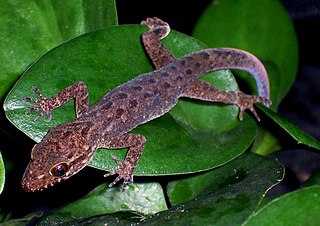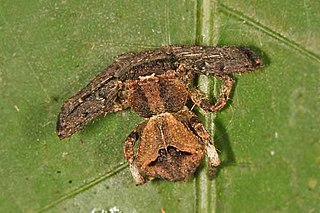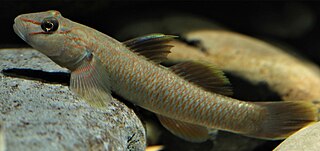
Cyrtodactylus is a diverse genus of Asian geckos, commonly known as bent-toed geckos, bow-fingered geckos, and forest geckos. The genus has 354 described species as of 2023, which makes it the largest of all gecko genera.
This list contains species first discovered in Hong Kong, with the endemic species asterisked.

Discoplax is a genus of terrestrial crabs. It is very closely related to the genus Cardisoma.

Rhinogobius is a genus of primarily freshwater gobies native to tropical and temperate parts of eastern Asia. Most are small, streamlined in shape, and often sexually dimorphic. Few are of commercial importance, but R. duospilus is fairly widely traded as an aquarium fish.
Milyeringa is a genus of blind cavefish from the Cape Range and Barrow Island, northwestern Australia. Although traditionally considered to belong to the family Eleotridae, studies show that they represent a distinct and far-separated lineage together with the Typhleotris cavefish from Madagascar, leading some to move them to their own family, Milyeringidae. The generic name is taken from Milyering which is 20 miles (32 km) southwest of Vlamingh Head in the North West Cape of Western Australia, the type locality for Milyeringa veritas.

Alcimochthes is a genus of Asian crab spiders that was first described by Eugène Louis Simon in 1885. As of June 2020 it contains three species, found in eastern Asia: A. limbatus, A. melanophthalmus, and A. meridionalis.

Cavefish or cave fish is a generic term for fresh and brackish water fish adapted to life in caves and other underground habitats. Related terms are subterranean fish, troglomorphic fish, troglobitic fish, stygobitic fish, phreatic fish and hypogean fish.

Neolithodes is a genus of king crabs, in the family Lithodidae. They are found in all major oceans, both in high and low latitudes. Although there are records from water as shallow as 124 m (407 ft) in cold regions, most records are much deeper, typically 700–2,000 m (2,300–6,600 ft), with the deepest confirmed at 5,238 m (17,185 ft). They are fairly large to large crabs that typically are reddish in color and spiny, although the size of these spines varies depending on species.
Hetereleotris is a genus of gobies native to the western Indian Ocean and the western Pacific Ocean.
Rhinogobius aporus is a species in the goby subfamily Gobionellinae endemic to China. It was first described as Pseudorhinogobius aporus, but that genus has been brought into synonymy with Rhinogobius.
Tengella is a genus of false wolf spiders that was first described by Friedrich Dahl in 1901. It is a senior synonym of Metafecenia.
Epidius is a genus of crab spiders that was first described by Tamerlan Thorell in 1877. It is a senior synonym of Pothaeus.

Wanda Wesołowska is a Polish zoologist known for her work with jumping spiders. She has described more species of jumping spider than any contemporary writer, and is second only to Eugène Simon in the history of arachnology. Originally a student of ornithology, she developed an interest in jumping spiders while still a student at the Siedlce University of Natural Sciences and Humanities in the 1970s.

Angaeus is a genus of Asian crab spiders first described by Tamerlan Thorell in 1881. It is considered a senior synonym of Paraborboropactus.

Nanhaipotamon is a genus of freshwater crabs, in the subfamily Potamiscinae, found in southern China and Taiwan. As of 2018, 18 species have been described. The genus is named after the South China Sea, for it occurs mostly in coastal areas. The genus was first described by R. Bott in 1968 as Isolapotamon (Nanhaipotamon), i.e., a subgenus of Isolapotamon.
Parveen F. Absar is a wildlife biologist from India. In 2017, she was credited with the discovery of a species of freshwater crab called Teretamon absarum, of the genus Teretamon and species speleaum.
This paleoentomology list records new fossil insect taxa that were described during the year 2014, as well as notes other significant paleoentomology discoveries and events which occurred during that year.

Rhinogobius candidianus is a species of freshwater goby. It is endemic to Taiwan.
Yuexipotamon is a monotypic genus of freshwater crabs in the subfamily Potamiscinae, found in the Heishiding Nature Reserve in Zhaoqing, south China, and first described in 2014. The only species is Yuexipotamon arcophallus. It superficially resembles Huananpotamon.









